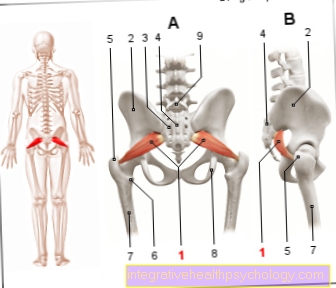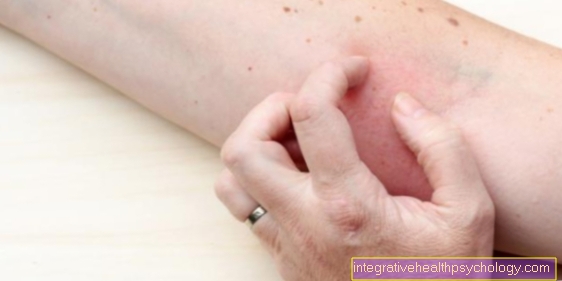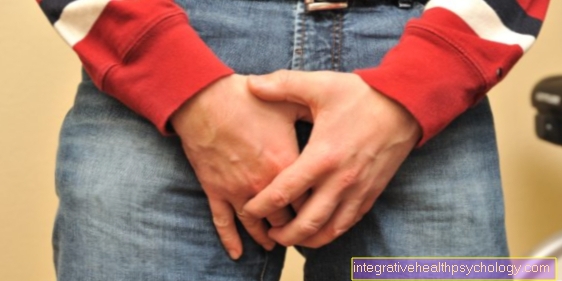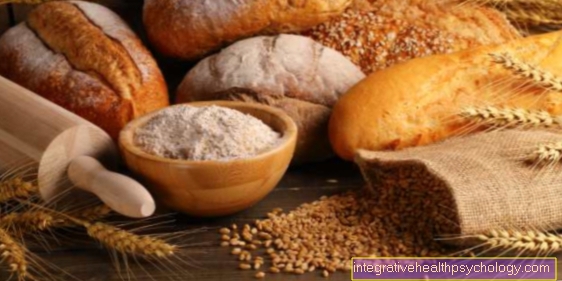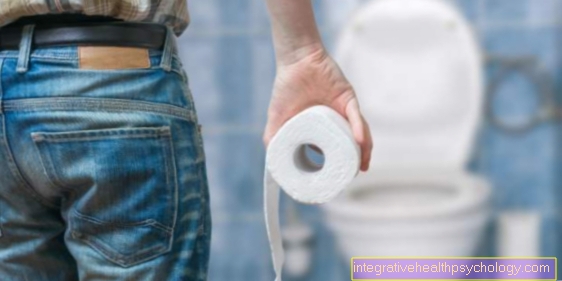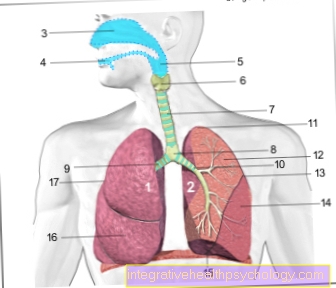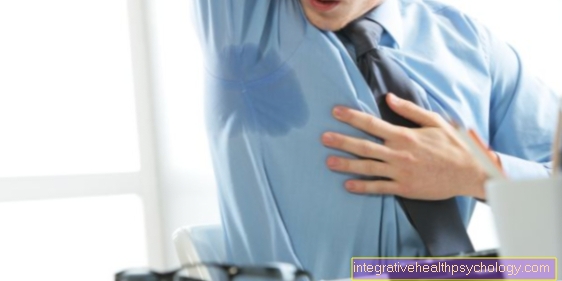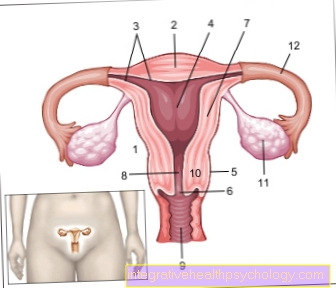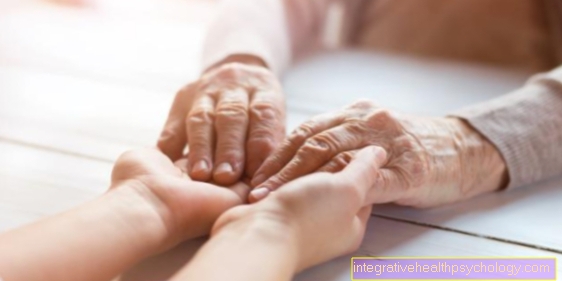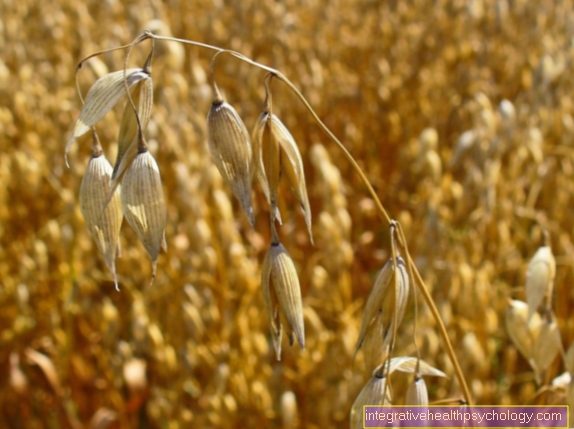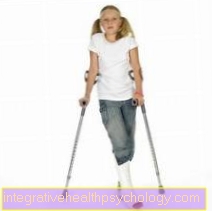Periosteum inflammation
synonym
Periosteum = periosteum
Periostitis = periostitis
Definition: periosteum
Periosteum is a thin layer encompassing the bones, well supplied with blood and supplied with nerves, which, in addition to a protective function, also serves to nourish the bones.

Structure of the periosteum
The periosteum covers all bones in the human body.
It is divided into two layers, an inner layer and an outer layer.
The inner layer is also called Osteogenic stratum designated. It contains i.a. bone-forming cells, also called Osteoblasts are designated. Above all, they will do more educational work when bone cells perish due to heavy stress on the bone. Even if fractures or necroses occur in the bone, the osteoblasts jump on and form more new bone cells.
This part of the periosteum is also responsible for supplying the bones with nutrients. For this purpose, nutrient-rich blood is brought into the bones via the blood vessels running in this layer.
In addition, numerous nerve cells run through this layer of the periosteum.
The second layer is the outer layer. It is also called Stratum fibrosum designated. Cell-poor connective tissue can be found here.
While the inner layer is mainly responsible for the metabolic processes and for the supply of the bone, the outer layer mainly has holding and supporting functions. The connective tissue pulls through the inner layer in the form of septa and penetrates the core of the bone, the so-called Compact one where it is anchored.
The bone itself has no nerve connection that can transmit sensitive stimuli.
The periosteum has correspondingly sensitive nerve supplies that are irritated in the event of trauma or injury and can thus transmit pain to the brain.
This part of the periosteum has a decisive role in the perception of pain and is therefore to be seen as a warning system for the bone. Even in the case of inflammation, the nerve tracts of the periosteum pass the pain stimulus on and thus indicate a serious illness.
Bone pain that is passed on through these nerve tracts is also often described in certain forms of leukemia.
The most harmless form of bone pain is the so-called growing pains, which are often observed in adolescents.
Read more on the subject at: The periosteum
Definition: periosteum inflammation
Periostitis is an inflammatory change in the periosteum resulting from various causes, which is often associated with severe pain and general systemic symptoms and can cause life-threatening circumstances.
Appointment with ?

I would be happy to advise you!
Who am I?
My name is dr. Nicolas Gumpert. I am a specialist in orthopedics and the founder of .
Various television programs and print media report regularly about my work. On HR television you can see me every 6 weeks live on "Hallo Hessen".
But now enough is indicated ;-)
In order to be able to treat successfully in orthopedics, a thorough examination, diagnosis and a medical history are required.
In our very economic world in particular, there is too little time to thoroughly grasp the complex diseases of orthopedics and thus initiate targeted treatment.
I don't want to join the ranks of "quick knife pullers".
The aim of any treatment is treatment without surgery.
Which therapy achieves the best results in the long term can only be determined after looking at all of the information (Examination, X-ray, ultrasound, MRI, etc.) be assessed.
You will find me:
- Lumedis - orthopedic surgeons
Kaiserstrasse 14
60311 Frankfurt am Main
You can make an appointment here.
Unfortunately, it is currently only possible to make an appointment with private health insurers. I hope for your understanding!
For more information about myself, see Lumedis - Orthopedists.
Causes of periosteum inflammation
In most cases, periostitis is caused by chronic overload. Above all, athletes who suddenly increase their training quota sharply without waiting for the corresponding training effects are affected by these overloads.
Walking or standing on a surface that is too hard or wearing the wrong footwear can accelerate or cause inflammation of the periosteum.
Furthermore, there is also the possibility that an inflammation of the periosteum is caused by a bacterial infection. The prerequisite for this is the penetration of a pathogen into the body.
A bacterial infection often occurs after an accident that results in deep skin injuries through which the corresponding pathogens can penetrate.
If they reach a nearby bone, there is in principle the possibility of infecting the periosteum. Even after surgical interventions in which bone was exposed, e.g. After the insertion of a knee or hip prosthesis, there is a risk that the corresponding pathogens can come into the vicinity of the bone and periosteum and infect them.
In comparison, however, periosteum inflammations that result from overloading are much more common.
Read more on the topic: Inflammation of the bone skin on the coccyx
Pathogenesis of periosteum inflammation
To Overuse or infection of the periosteum there is one Swelling of the periosteum, which are also called Periosteal edema referred to as.
In this inflammatory stage, connective tissue structures and increasing ossification processes are involved in the inflammatory process.
This swelling results in increased pressure and tension on the periosteum, which leads to irritation of the neural structures.
This irritation is then felt in the form of pain.
The body usually reacts with an appropriate defense reaction, especially when it is a bacterial Is related periosteum inflammation. This includes the Activation of the Immune system, white blood cells (Leukocytes are increased), possibly fever and increased levels of inflammation (increased CRP levels).
Symptoms of periostitis
These symptoms can be used to recognize periosteum inflammation
-
Pain
-
In peace
-
at pressure
-
under pressure
-
-
swelling
-
overheat
-
Reddening of the skin over the affected area
-
Limited mobility and functionality of the body part
Furthermore, general symptoms such as
- Fatigue,
- general malaise and
- Fever occur.
In the blood count, an increased leukocyte count and an increase in CRP can indicate an inflammation of the periosteum.
Pain
In the case of periosteum inflammation, the pain is triggered by the inflammatory cells that are produced in the body during the disease.
These cells are supposed to work against periosteum inflammation, but at the same time they stimulate the nerve fibers that transmit pain to the brain.
In the case of periosteum inflammation, however, pain is also to be understood as a warning signal from the body.
Since they are usually stronger when they are stressed than when they are at rest, they virtually ask the person concerned not to stress themselves too much.
This allows the bone to recover and the inflammation to heal.
swelling
In addition to pain and redness, swelling is a typical sign of inflammation.
In the case of periosteum inflammation, swelling is often not immediately visible because the processes in the body take place a little below the skin.
However, since in most cases the shin bone is affected by the periosteum inflammation and there is very little tissue over the bone, the swelling usually comes to the fore sooner.
In periosteum inflammation, the swelling is also caused by the inflammatory cells that the body sends into the tissue to ward off the disease.
The many cells take up a lot of space and there is also an increase in fluid accumulation.
This creates a swelling at the site of the inflammation.
Diagnosis of periosteum inflammation
Diagnostically, the physical examination can provide an indication of periostitis.
If the patient reports pain when touching the skin over the corresponding bone, this could indicate an inflammation of the periosteum.
A X-ray is only meaningful in the case of severe and prolonged courses and would in this case be a ossification (Ossification) at the edge of the corresponding bone.
If in doubt, you can still use a MRI of the respective region or a Skeletal scintigraphy which can detect increased metabolic processes in the area of the bone.
But here, too, it is above all difficult courses and chronic inflammation such Periostitis can make visible.
Treatment of periosteum inflammation
Treatment is more symptomatic and can be divided into drug therapy and non-drug therapy.
Non-medication can be used to try to relieve the symptoms with cooling and a pressure bandage.
Furthermore, the triggering factors, such as incorrect footwear or excessive training, should be eliminated.
Medicinally, anti-inflammatory and analgesic drugs should be used.
Medicines such as ibuprofen or Voltaren®, which fulfill both tasks, are suitable for use for a limited period of time.
Learn more about: Non-steroidal anti-inflammatory drugs
If there is severe pain, the corresponding bone should also be spared.
General symptoms, such as fever, should be treated with leg wraps if the temperature cannot be lowered with the above medication.
Only chronic inflammations that keep recurring are operated on. In this case, a split of the periosteum would be performed.
Read more on the topic: This is how long periosteum inflammation lasts
Can these ointments help?
Ointments that help with periosteum inflammation are primarily cooling and pain relieving ointments.
This includes, for example, the Voltaren® and the Docsalbe®.
Voltaren® contains the active ingredient diclofenac, while Docsalbe® contains ibuprofen.
Both active ingredients are drugs that have both analgesic and anti-inflammatory effects.
By applying them to the skin in the immediate vicinity of the periosteum inflammation, the active ingredients can quickly reach the inflamed area and calm the pain there.
In addition, the ointment with its gel is cooling and thus also counteracts the inflammation and overheating of the affected body part.
An ointment bandage is particularly useful if the ointments are to take effect a little longer. A little ointment is put on a compress and this is placed on the skin over the painful area.
The compress can then be connected with a gauze bandage.
Ideally, such an ointment bandage is put on in the evening so that the ointment can work overnight.
Contrary to some recommendations that are circulating on the Internet, the use of heparin ointment is not recommended in case of periosteum inflammation.
This works on bruises by acting as a blood thinning agent to remove the bruises more quickly.
However, this active ingredient is not helpful for periosteum inflammation!
These home remedies can help
Home remedies that help against periosteum inflammation are primarily aimed at cooling the affected body part.
A simple cold pack is usually sufficient for this. This should be wrapped in a towel to protect the skin on the affected area and used for cooling for about ten to twenty minutes.
A wet, cold towel or a bag of ice cubes can also be used. Other home remedies are, for example, quark compresses, cabbage and savory pouches, which also have a cooling effect.
The same effect can be achieved by bathing the affected body part in cold water.
cold
In the case of periosteum inflammation, cold is the most important therapeutic means in addition to protecting the body.
Inflammation leads, among other things, to overheating of the affected part of the body. Similar to a fever with a cold, the body tries to destroy the triggers of the periosteum inflammation with heat.
However, this reaction causes the pain, which is why cooling the affected area has a pain-relieving effect.
The swelling is also reduced by cooling and elevating the affected body part.
Cooling can be done using ice packs, ice packs or cold water.
Other home remedies such as quark compresses can also be used.
Quark wrap
Quark compresses are a common home remedy for cooling all types of injuries and inflammation.
Conventional quark from the supermarket can be used to make a quark wrap. This should come from the refrigerator.
The quark is placed on a kitchen towel or cling film, then the quark wrap is placed on the painful part of the body.
The cold quark has an immediate cooling effect. This is usually a bit more moderate and therefore not as damaging to the skin as an ice pack.
Due to its moisture, the cooling lasts for a long time.
The quark wrap should remain on the skin as long as it gives off cold (usually a maximum of 30 minutes). A new wrap can then be used
Savior lace envelopes
Savory poultices can be used to relieve pain as well as to inhibit inflammation of the periosteum.
To do this, the Retterspitz is placed on a cloth and placed on the affected part of the body.
Due to its various active ingredients, it can counteract periosteum inflammation in different ways.
For example, arnica is contained in Retterspitz, which can have a pain-relieving effect.
Essential oils such as thymol and rosemary oil also have anti-inflammatory effects.
The combination can be a very effective therapy for periosteum inflammation.
In addition, the Retterspitz has a self-cooling effect and can thus also alleviate the symptoms.
homeopathy
In the case of periosteum inflammation, different homeopathic remedies are used depending on the severity.
Apisinum and Apis mellifica are particularly effective when the swelling is the main symptom.
Potassium iodatum, on the other hand, is more effective against the inflammation itself. If the symptoms are weather-dependent and even improve somewhat through slight movement, Ruta graveolens can also be used.
In conjunction with cooling home remedies, the symptoms of periosteum inflammation can usually be effectively alleviated.
If this is not enough, however, taking painkillers is also recommended.
Taping
When it comes to taping, a distinction is made between two types of tape:
- Stabilizing, firm (mostly white) tape is mainly used on joints. Since the joints are rarely affected by periosteum inflammation, the stabilizing tape is often of no help. However, if the inflammation occurs near the joint, this can provide relief.
- As a rule, however, the use of kinesiotape is more helpful and effective. This very elastic tape supports the muscles in their function and can relieve stressed areas. The kinesiotape can work very well with periosteum inflammation on the shin
Can cortisone help and when should it be used?
Cortisone is not the first drug of choice for periosteum inflammation.
Pain relievers and anti-inflammatory agents are much more helpful.
But cortisone can be very helpful, especially in the case of particularly stubborn periosteum inflammations that turn into chronic inflammation.
Periosteum inflammation leads to the typical symptoms only through the reaction of the immune system on the bone.
Cortisone can downregulate this immune response and thus put a stop to inflammation.
Read more about this under: Cortisone
Which doctor treats periostitis?
Since periosteum inflammation is usually a disease of the musculoskeletal system, the orthopedic surgeon is usually the best contact for the complaints.
However, the symptoms can also be recognized and treated by your family doctor.
However, because diagnostics are useful to rule out other causes of the pain, general practitioners refer most affected persons to an orthopedic surgeon.
Duration of periosteum inflammation
General information on the duration of periosteum inflammation can unfortunately only be made to a limited extent. This is mainly because it depends on the extent, intensity and cause of the periosteum inflammation, as well as on the consistency with which the patient follows the therapy instructions. For this reason, the information given below can only be viewed as guide values.
In the case of milder forms of periosteum inflammation due to overload, it can be assumed that the basic measures described above should provide comprehensive relief within 1-2 weeks. Nevertheless, you should not rush to start again with heavy stress, whether in professional life, leisure or sport, in order not to endanger the success of the therapy. Slowly increasing the load is therefore the key to success in order to achieve lasting relief from the symptoms.
In more severe cases, treatment of periosteum inflammation caused by overload can take several weeks or even a few months. Here, too, the duration of treatment depends to a large extent on the patient's adherence to therapy. If there is insufficient adherence to therapy, periosteum inflammation can even become chronic. In this condition, it is very difficult to treat effectively. If such chronification now occurs, surgical treatment can be considered. Following this, the affected part of the body should be spared consistently for several weeks to a month.
If the cause of the periosteum is a bacterial infection, a relatively quick response to the medication administered can usually be expected. Since the periosteum is not due to overload, in this case the deciding signal for the resumption of the stress is not the subsidence of the pain in the affected bone, but the overall physical condition (such as the subsidence of the fever that may have occurred at the same time) of the patient.
Read more on the topic: This is how long periosteum inflammation lasts
What can be the long-term consequences of periosteum inflammation?
Periosteum inflammation can be very tedious to treat, but often does not have any long-term consequences.
With sufficient physical restraint, the symptoms can completely disappear after a few months. Nevertheless, there is still the risk that the periosteum will break out again and again result in decreased resilience and sports ability.
Anyone who permanently suffers from periosteum inflammation can develop chronic pain.
These result in restricted mobility, which can have a negative impact on physical fitness, but also on the mental state of those affected.
Localization of periosteum inflammation
Basically all bones can be affected by periosteum inflammation.However, the bones, on the surface of which the corresponding muscle tendons attach, are particularly often affected.
The inside of the shin (Tibia) is a bone that is often affected by periostitis because these conditions prevail there.
Read more on the topic:
- Inflammation of the bone skin on the coccyx
- Periosteum inflammation on the knee
Periosteum inflammation on the shin
Periosteum inflammation (Periostitis) of the shin has its origin in the vast majority of cases in excessive exercise. It occurs mainly in endurance runners and athletes, especially football. The disease is particularly favored by a too rapid increase in training. As a possible non-infectious cause, blows or kicks to the shin are also possible, albeit much less often. As with other periostitis, swelling and reddening of the affected area are symptomatic. Pain occurs primarily when pressure is applied to the inflamed area and increases in intensity with exertion.
The treatment of periostitis of the tibia hardly differs from the periostitis in other parts of the body and is just as lengthy. Immobilizing the tibia is a top priority. Cooling and anti-inflammatory or pain relieving drugs such as ibuprofen or diclofenac are also very helpful. As long as there is significant pain during exercise, no sport should be practiced. This can take several weeks.
If the worst pain has subsided, you should first switch to more gentle sports such as swimming and cycling. Furthermore, more attention should be paid to the anterior shin muscles in the future. Targeted strength training and stretching of these muscles can prevent renewed periosteum inflammation.
Read more on this topic at: Periosteum inflammation on the shin
Elbow
As well as periosteum inflammation (Periostitis) of the shin, periostitis of the elbow is often the result of excessive exercise. Sports such as golf, athletics, volleyball, squash or tennis are in the foreground. In addition to swelling and reddening of the affected elbow, tenderness and increasing pain when exercising are in the foreground.
The tennis elbow and the golfer's elbow should be mentioned in particular.
From a therapeutic point of view, immobilization of the bone, possibly over several weeks, is particularly important here; a tape bandage is well suited for this. In addition, the elbow should be cooled.
Pain relieving and anti-inflammatory drugs like ibuprofen and diclofenac are also recommended. A new start in the training should be undertaken slowly, possibly first gentle sports such as swimming or cycling should be chosen. Sufficiently long warm-up and rest phases should play an important role.
Please also read our topics:
- Periosteum inflammation on the elbow
- Tennis elbow
- Taping a tennis elbow
- Treatment of a tennis elbow
- Golfer's elbow
Foot and heel
Periostitis of the foot is often the result of foot deformities in combination with running training. Running training in connection with being overweight or simply jogging on hard surfaces with insufficient cushioning from the shoe sole can also be the cause.
In addition to the generally applicable principles for the treatment of periosteum inflammation, the focus is now on eliminating the cause. An analysis of the foot roll behavior should be carried out by the orthopedic surgeon or at least in a running shoe store. On the basis of this, suitable footwear can ultimately be selected. Orthopedic insoles can also be helpful. A return to training should be started slowly; Gentle sports such as cycling and swimming are well suited for this.
hip
Periosteum inflammation (Periostitis) the hip is quite rare overall. Like other periostitis, it typically occurs muscular overuse of the adjacent muscles or related to bacterial infections. Also Blows or Bumps on the bones can cause periosteum inflammation. Here, too, typical symptoms are pain when pressure is applied to the inflamed area and, above all, when there is pressure and swelling.
Healing of periosteum inflammation is also quite tedious on the hip. The only therapeutic options are to immobilize the hip and stop exercising for several weeks, as well as cooling down and taking pain reliever and anti-inflammatory drugs.
In any case, prolonged pain in the hip should be clarified by a doctor.
wrist
Periosteum inflammation (Periostitis) on the wrist often have their origin in more frequent work on the PC. But also Blows on the wrist can be a Periostitis trigger. Periosteum inflammations, especially on the hand, represent a deep turning point in everyday life. Typically, they are associated with pain when strained and especially when trying to grip objects.
In addition, a swelling and Redness of the wrist.
The therapy of periostitis consists primarily in one Immobilization, as well as one cooling of the wrist. Pain reliever and anti-inflammatory drugs like Ibuprofen and Diclofenac are also recommended.


